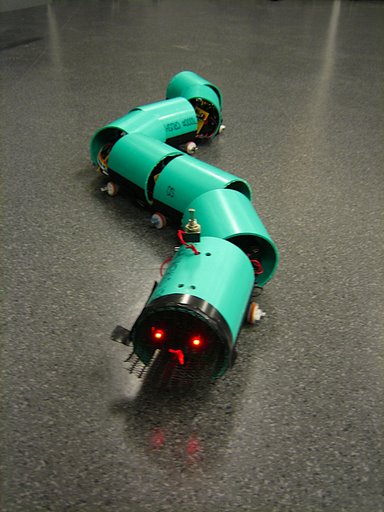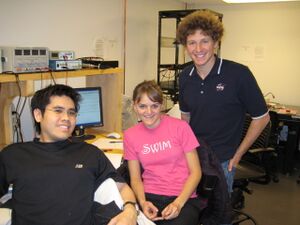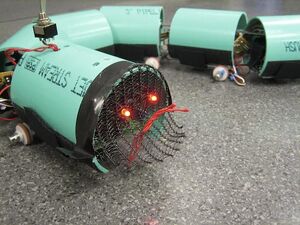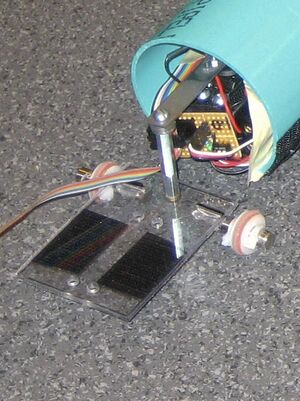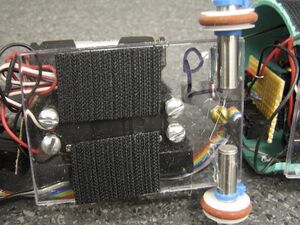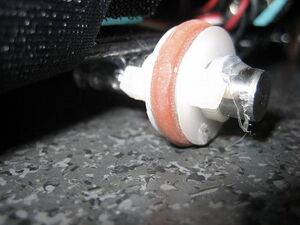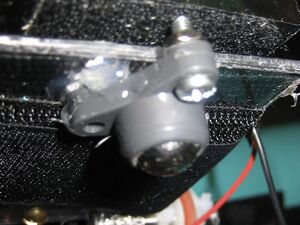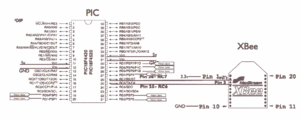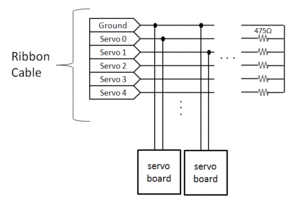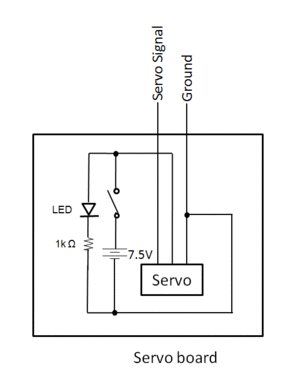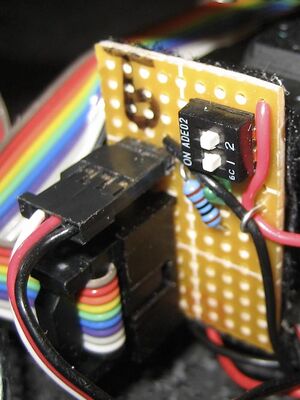Difference between revisions of "Robot Snake"
AndrewLong (talk | contribs) |
AndrewLong (talk | contribs) |
||
| Line 124: | Line 124: | ||
==== Fully Assembled Body Segment ==== |
==== Fully Assembled Body Segment ==== |
||
[[image:BuiltChasis.jpg|thumb|right|A Chasis Built Showing a Standoff and Batteries]] |
[[image:BuiltChasis.jpg|thumb|right|A Chasis Built Showing a Standoff and Batteries]] |
||
A fully assembled chassis has a mounted servo and is connected to a segment on either side. AAA batteries packs were attached to the sides of the motor with velcro to allow easy removal. The small electronic circuit board for each segment was mounted on the front of the motor to allow easy access to the switch. (See Electronic Design for more information on the circuit board and batteries |
A fully assembled chassis has a mounted servo and is connected to a segment on either side. AAA batteries packs were attached to the sides of the motor with velcro to allow easy removal. The small electronic circuit board for each segment was mounted on the front of the motor to allow easy access to the switch. (See Electronic Design for more information on the circuit board and batteries) |
||
<br clear=all> |
<br clear=all> |
||
Revision as of 11:32, 20 March 2008
Overview
In this project, we developed and built a robot to mimic serpentine motion of a snake. The robot is made up of several body segments and a head. Each body segment contains a RC servo, which is controlled by a PIC microntroller located in the head of the snake robot. This wiki page contains discussions of the motion of a snake, mechanical design, electronic design and PIC code.
Team Members
- Michael Hwang - Electrical Engineer - Class 2008
- Andrew Long - Mechanical Engineer - Class 2009
- Clara Smart - Electrical Engineer - Class 2009
Snake Motion

Snakes are able to adapt their movement to various environments. For instance, snakes can move across extreme environments such as sand, mud and water. Research has discovered there are four types of snake motion, as shown in the image. These motions include serpentine movement, rectilinear movement, concertina movement and side-winding movement. The most common motion exhibited by most snakes is serpentine motion where each section follows a similar path (Ma, 205). In order for snakes to successfully locomote using serpentine motion, the belly of the snake must have anisotropic coefficients of friction for the normal and tangential directions. Specifically, the normal friction must be greater than the tangential friction. As a result, when the snake exhibits a force on the ground, it will move in the tangential direction without slipping in the normal direction. (Saito et al, 66)
Advantages / Disadvantages of Robotic Snake Motion
Advantages
Many robots are limited by the use of motorized wheels. However, there are many advantages for building a robot that mimics the motion of a snake. Several advantages for movement of a snake robot are listed below:
- Move across uneven terrain, since it is not dependent on wheels
- Possibly swim if water-proofed
- Move across soft ground such as sand, since it can distribute its weight across a wider area
Also, from a systems standpoint, the snake robot can be very modular with many redundant segments. As a result, it is very easy to replace broken segments as well as shorten or lengthen the robot.
Disadvantages
Although there are many advantages for building a snake like robot, there are several disadvantages which are listed below:
- Low power and movement efficiency
- High cost of actuators (servos or motors)
- Difficult to control high number of degrees of freedom
(Ma, 206)
Robot Snake Motion
Real snake motion does not follow specified equations. However, research has proven that the serpentine motion of a snake can be modeled with the following equations (Saito etal, 72-73):
where the parameters a, b, and c determine the shape of the serpentine motion. The graph shows how the parameters influence the serpentine curve. Basically, a changes the appearance of the curve, b changes the number of phases, and c changes the direction.
The serpentine curve can be modeled with a snake like robot by changing the relative angles between the snake robot segments using the following formula with the number of segments (n):
where α , β , and γ are parameters used to characterize the serpentine curve and are dependent on a, b, and c as shown below:
The equations above for φi,α,β, and γ were used in this snake like robot as shown in the code section.
Mechanical Design
The robotic snake consists of a head segment and several body segments. The head segment houses the onboard microcontroller and xBee radio. The body segments house the servo motors and the batteries required to power each motor. As the snake is designed to be modular, there is no limit to the number of body segments. More segments will allow it to move more smoothly, while fewer segments will be easier to control. For this design, seven body segments were used due to material limitations.
Mechanically, the snake is designed to move in a serpentine motion, imitating the motion of a real snake. As discussed above, real snakes move with anisotropic coefficients of friction. It is difficult to locate materials with this property, but passive wheels satisfy the friction requirements. The friction will be lower in the direction of rolling, thus providing the required difference in friction. The only problem with this approach is that the wheel may slide in the normal direction if the weight applied to the wheel is not sufficient.
Parts List
- Motors: Futaba S3004 standard ball bearing RC servo motor, Tower Hobbies LXZV41 $12.99
- Wheels: McMasterCarr Acetal Pulley for Fibrous Rope for 1/4" Rope Diameter, 3/4" OD McMasterCarr 8901T11 $1.66
- O-Rings (Tires): McMasterCarr Silicone O-Ring AS568A Dash Number 207, Packs of 50 McMasterCarr 9396K209 $7.60/50
- PVC Pipe: McMasterCarr Sewer & Drain Thin-Wall PVC Pipe Non-Perforated, 3" X 4-1/2' L, Light Green McMasterCarr 2426K24 $7.06
- 1/8th inch plastic for chassis: (Shop Stock) or McMasterCarr Polycarbonate Sheet 1/8" Thick, 12" X 12", Clear, McMasterCarr, 8574K26 $6.32
- Dowel Pins: 1" long, 1/4" diameter
- Sheet Metal: For the connecting segments
- Fasteners: Screws for the servos and chassis, washers for the standoffs
- Standoffs: Used 1" and 1/2" to achieve a level snake
- Velcro: To attach battery packs and housing to the chasis
- Ball caster: For the head
The Body Segments
Each of the body segments are identical and includes a chassis, a servo, a connector, standoffs and two passive wheels as can be seen in the picture.
Chassis
The base of the chassis is made from a thin (approx. 1/8th inch) piece of polycarbonate. The chassis must be wide enough to hold a servo motor with a AAA battery pack on each side and long enough for the servo and a standoff (the connection for the previous segment). The polycarbonate was cut into a rectangle to meet the specifications for our servo motor. Five holes were then drilled in the rectangle, four to mount the servo and one for the standoff. The holes are drilled to allow the servo to be located in the center of the chassis.
Connector
A connector was machined to attach to the servo horn of one body segment and to attach to the next segment's standoff. The length of this connector is about 3 inches and is just long enough to prevent collision between segments. A shorter beam allows for greater torque. This connection needs to be as tight as possible and the beam must be mounted perpendicular to the chassis.
Standoffs
Standoffs were used to attach the servo to the chassis and to attach the connector to the chassis. Two standoffs (1 in and 1/2 in) and several washers were used to make the connector parallel to the ground.
Passive Wheels
Passive wheels were mounted to the bottom of the chassis. Each wheel was made of a 3/4 inch pulley and an o-ring. The o-ring was used to increase friction with the ground. The wheels have been set on polished metal dowel pins which allow the wheels to rotate more freely than when placed on wooden dowels. The dowel pin axles were mounted (hot glue works but is not very strong) in the center of the segment. The center of the segment is not the center of the polycarbonate rectangle. Instead, the entire segment length is the distance from the standoff on one chassis to the center of the servo horn on the other. In this project, the length of the connector was made to be about half the length of the segment. Therefore, the wheels were placed at the same location as the stand off as can be seen in the image. The wheels are held in place with zip ties.
Fully Assembled Body Segment
A fully assembled chassis has a mounted servo and is connected to a segment on either side. AAA batteries packs were attached to the sides of the motor with velcro to allow easy removal. The small electronic circuit board for each segment was mounted on the front of the motor to allow easy access to the switch. (See Electronic Design for more information on the circuit board and batteries)
The Head Segment
The head segment is similar to the body segments except that it contains a PCB board with a PIC instead of a servo motor. The head segment is the same width but slightly longer than the body segment. A ball caster was added to the front of the segment to help support the extra length and help the wheels stay on the ground.
Protection and Visual Appeal
As a final step, housing for each segment was created from 3" PVC pipe. The pipe was cut into segments the same length as the chassis. The bottom of the pipe was cut off, allowing it to sit flat on the chassis. The housing provides a protective covering for the servo, batteries and electronics. The pipe was attached with velcro straps which mounted under the chassis. This housing can be easily removed to debug and to change batteries.
Mechanical Debugging
Wheels come off the ground: Add washers to the standoffs to force the chassis to be parallel to the ground.
Wheels slide, but do not roll: Increase frictionby either adding weight to the segment or changing the "tires" (the o-ring).
The segments slip when the servo rotates: Tighten the screws for the connector standoffs, both above the beam and below the chassis.
Electronics
Parts List (Digikey Part Number)
- PIC: PIC18F4520
- Oscillator: 40MHz Oscillator (X225-ND)
- RC Servo (see mechanical design) preferably high-torque
- 10 wire IDC ribbon cable
- 10 pos IDC cable socket (ASC10G)
- 10 pos IDC cable header (A26267-ND)
- 3 pos AAA battery holder (BH3AAA-W-ND)
- 2 pos AAA battery holder (BH2AAA-W-ND)
- 475 Ohm resistors (transmission line termination)
- Various switches to turn power electronics and the motors on/off
- Standard Protoboard, to mount connector from ribbon cable, and switches for each motor
- Xbee radio pair and PC
Electronics in Each Body Segment
The each segment of the snake contains a Futaba Standard RC Servo. Each servo has 3 wires: power, ground, and signal. The signal generated by the microcontroller is carried by the IDC ribbon cable, and each servo board taps into a single signal line and the reference ground line. At each motor, a small circuit board contains the connector for the ribbon cable, a switch to control the power and a power indicator LED. This circuit board has a common ground, connecting the signal ground with the battery ground and receives power from the batteries. Because of the length of the ribbon cable, each signal line must be terminated with a 475 ohm resistor to prevent reflected "ghost" signals from interfering with the original signal.
Each servo board also has its own power supply of 5 AAA cells, which gives each servo 7.5V. Although the servos are only rated for 6V, 7.5V was used because more torque was needed. The current drain (up to 500mA) caused the voltage across the cells to drop due to the high internal resistance of the alkaline cells. NiMH rechargeable cells are more capable of handling high current draw applications, but are also much more expensive and can take several hours to charge.
The robot snake can run for about 1 hour on the alkaline cells, after which the servos no longer have enough torque to generate the serpentine motion.
Electronics in The Head Segment
The PIC /PIC board and power to the PIC Board
The Xbee Radio
PIC Code
There are two PIC files used in this robotic snake, SnakeServos.c and main.h, which are shown below. main.h sets up the default parameters used in SnakeServos.c. The microcontroller controls the RC servos and communicates via serial communication to a computer. These two functions are discussed below.
Servo Control
The main function of the PIC microcontroller was to control multiple servos (seven in our case). Timer1 is set to overflow every 20 milliseconds and trigger an interrupt. When the interrupt is triggered, Timer1's counter is set to the value held by TMR1_20MS, which will cause the interrupt to trigger again 20 ms later. At the beginning of the interrupt, all the pins connected to the servos are set high. While Timer1 is less than the value held by TMR1_2point25MS, Timer1 is polled, and the value is compared sequentially to the values in the RCservo array. If the value of Timer1 is greater than a value in RCservo, the the corresponding pin is set low. After all the values have been compared, Timer1 is polled again and the process repeats until 2.25 ms have elapsed (when Timer1 > TMR1_2point25MS). After all the servos signals have been sent, the values in the RCServo array are updated to prepare it for the next 20ms interrupt.
Although this method of timing the pulse trains has a lower resolution than using interrupts (see RCservoSoft.c), it allows one to add and remove servos more easily and not have to decrease the frequency of the servo signal pulse train. With a 40MHz clock and seven servos, the resolution was about 8us, which was good enough for this purpose.
Serial Communication
The PIC communicates serially with a XBee radio. When a byte is received in the UART receive buffer, a high-priority interrupt is triggered. The received byte is put into a switch-case statement, and the corresponding parameters are updated. As shown in the code, the serial communication allows the user to change the speed, the amplitude and phase of the sinewave, and the direction (forward, reverse, left and right) of the robotic snake.
SnakeServos.c
/*
Andy Long, Clara Smart, and Michael Hwang's snake robot code.
*/
#include <18f4520.h>
#device high_ints=TRUE // this allows raised priority interrupts, which we need
#fuses HS,NOLVP,NOWDT,NOPROTECT
#use delay(clock=40000000)
#use rs232(baud=9600, UART1)
#include <main.h>
#include <math.h>
/*
Put your desired high duration here;
3200 is center
1000 is 90 deg right
5400 is 90 deg left
*/
int16 RCservo[7];
volatile float a = A_DEFAULT;
volatile float b = B_DEFAULT;
volatile float c = C_DEFAULT;
volatile float alpha;
volatile float gamma;
volatile float beta;
volatile float speed = 0;
volatile float prev_speed = SPEED_DEFAULT;
float t = 0;
#INT_TIMER1 // designates that this is the routine to call when timer1 overflows
//generates servo signals
void ISR_20MS(){
volatile unsigned int16 time;
set_timer1(TMR1_20MS);
SET_ALL_SERVOS(0b11111111);
time=get_timer1();
while(time < TMR1_2point25MS){
if (time > (RCservo[0] + TMR1_20MS)){
output_low(SERVO_0);
}
if (time > (RCservo[1] + TMR1_20MS)){
output_low(SERVO_1);
}
if (time > (RCservo[2] + TMR1_20MS)){
output_low(SERVO_2);
}
if (time > (RCservo[3] + TMR1_20MS)){
output_low(SERVO_3);
}
if (time > (RCservo[4] + TMR1_20MS)){
output_low(SERVO_4);
}
if (time > (RCservo[5] + TMR1_20MS)){
output_low(SERVO_5);
}
if (time > (RCservo[6] + TMR1_20MS)){
output_low(SERVO_6);
}
time=get_timer1();
}
SET_ALL_SERVOS(0);
//3200 is center //1000 is 90 deg right // 5400 is 90 deg left
/*
add value of sine wave with phase offset ((alpha*sin(t + X*beta),
3200 for servo center position,
an adjustment value to compensate for offsets when mounting servo horn (SERVO_X_ADJ),
and bias (gamma) for turning.
*/
RCservo[0]=(int16)(alpha*sin(t) + 3200 + SERVO_3_ADJ + gamma);
RCservo[1]=(int16)(alpha*sin(t + 1*beta) + 3200 + SERVO_4_ADJ + gamma);
RCservo[2]=(int16)(alpha*sin(t + 2*beta) + 3200 + gamma + SERVO_5_ADJ);
RCservo[3]=(int16)(alpha*sin(t + 3*beta) + 3200 + gamma + SERVO_6_ADJ);
RCservo[4]=(int16)(alpha*sin(t + 4*beta) + 3200 + gamma + SERVO_7_ADJ);
RCservo[5]=(int16)(alpha*sin(t + 5*beta) + 3200 + gamma + SERVO_8_ADJ);
RCservo[6]=(int16)(alpha*sin(t + 6*beta) + 3200 + gamma + SERVO_9_ADJ);
t+= speed;
if (t > 2*pi){
t = 0;
}
else if (t < 0){
t = 2*pi;
}
}
#INT_RDA HIGH //High-Priority Interrupt triggered by USART Rx
//parameter update
void ISR_USART_RX(){
char input;
if (kbhit()){
input = getc();
switch(input){
case 'w': //accelerate
speed += 0.002;
break;
case 's': //decelerate
speed -= 0.002;
break;
case 'x': //pause motion
prev_speed = speed;
speed = 0;
break;
case 'z': //resume motion
speed = prev_speed;
break;
case 'c': //reverse speed
speed = -speed;
break;
case 'a': //increase left turn rate
c -= 1000;
gamma=-c/num_segments;
break;
case 'd': //increase right turn rate
c += 1000;
gamma=-c/num_segments;
break;
case 'f': //set turn rate to 0
c = C_DEFAULT;
gamma = 0;
case 't': //increase amplitude
a += 10;
alpha=a*abs(sin(beta));
break;
case 'g': //decrease amplitude
a -= 10;
alpha=a*abs(sin(beta));
break;
case 'y': //increase phases in body
b += 0.1;
beta=b/num_segments;
alpha=a*abs(sin(beta));
break;
case 'h': //decrease phases in body
b -= 0.1;
beta=b/num_segments;
alpha=a*abs(sin(beta));
break;
case '1': //preset 1
a = A_DEFAULT;
b = B_default;
c = C_default;
gamma=-c/num_segments;
beta=b/num_segments;
alpha=a*abs(sin(beta));
speed=SPEED_DEFAULT;
break;
case '2': //preset 2
a = 1400;
b = 2*pi;
c = C_DEFAULT;
gamma=-c/num_segments;
beta=b/num_segments;
alpha=a*abs(sin(beta));
speed=SPEED_DEFAULT;
break;
case '3': //preset 3
a = 1000;
b = 5*pi;
c = C_DEFAULT;
gamma=-c/num_segments;
beta=b/num_segments;
alpha=a*abs(sin(beta));
speed=SPEED_DEFAULT;
break;
default:
}
}
return;
}
void main() {
a = A_DEFAULT;
b = B_default;
c = C_default;
gamma=-c/num_segments;
beta=b/num_segments;
alpha=a*abs(sin(beta));
speed=0;
setup_timer_1(T1_INTERNAL | T1_DIV_BY_4 );
set_timer1(0);
enable_interrupts(INT_TIMER1);
enable_interrupts(INT_RDA);
enable_interrupts(GLOBAL);
while (TRUE) {
}
}
main.h
#ifndef __MAIN_H__ #define __MAIN_H__ #define SET_ALL_SERVOS(x) output_d(x) /* This chart matches the pin on the PIC to the wire on the ribbon cable PIN WIRE IN USE --- ---- ------- RD0 2 RD1 3 * RD2 4 * RD3 5 * RD4 6 * RD5 7 * RD6 8 * RD7 9 * */ #define SERVO_3_ADJ 0 #define SERVO_4_ADJ 300 #define SERVO_5_ADJ (-150) #define SERVO_6_ADJ 75 #define SERVO_7_ADJ (-200) #define SERVO_8_ADJ 100 #define SERVO_9_ADJ (-150) #define SERVO_0 PIN_D1 #define SERVO_1 PIN_D2 #define SERVO_2 PIN_D3 #define SERVO_3 PIN_D4 #define SERVO_4 PIN_D5 #define SERVO_5 PIN_D6 #define SERVO_6 PIN_D7 #define A_DEFAULT 1300 #define B_DEFAULT 3*pi #define C_DEFAULT 0 #define SPEED_DEFAULT 0.05 #define OMEGA_DEFAULT 1 #define num_segments 8 #define TMR1_20MS 15536 #define TMR1_2point25MS 15536 + 6250 #endif
Results
Overall, the robotic snake was successful.
Initially, the mechanical design included a single wheel mounted in the center of the pvc pipe. However, the motion of the snake was very difficult to control because the robotic snake became unstable very easily. As a result, the chassis was built to include two wheels, as discussed in the mechanical design section, in order to provide stability which made the robot easier to control.
Wireless control from a laptop allowed easy demonstration of the snakes capabilities, and allowed others to easily control its movement.
The final robotic snake can be seen in action here. (insert link for youtube video)
Next Steps
The robotic snake was developed within five weeks, and proved to be a very successful demo. There are many options that could be researched and developed to add to this robot and discussed below.
Position Sensors
Sensors could be added to the robot to allow it to know its position. This could be accomplished with a combination of encoders on a segment. Most likely, the middle segment should be used since it would be the approximate center of gravity. Knowledge of the position of the center of gravity would potentially the robotic snake to be sent to different locations or navigate (using dead reckoning) through a pre-determined obstacle course or maze. The information from encoders could be sent to a computer to observe different snakelike motions with different parameters.
Obstacle Avoidance
With optical sensors on the head of the snake, the robot would be able to sense an obstacle and either overide the wireless command and avoid it, or stop completely, and wait for further commands.
Power Supply
Currently, 5 AAA batteries are required for each servo, meaning that this robot requires many batteries. As a result, a different power supply could be investigated.
High Torque Servos
The servos in the snake have a large load but do not need to move very quickly, so high torque servos should be used instead of standard servos. This would also prolong the battery life because the servos would be operating in a more efficient range.
References
Ma, Shugen. "Analysis of creeping locomotion of a snake-like robot." Advanced Robotics Vol 15, No 2 (2001): 205-6.
Saito, Fukaya, Iwasaki. "Serpentine Locomotion with Robotic Snakes". IEEE Control Systems Magazine (Feb 2002): 66, 72-73.
